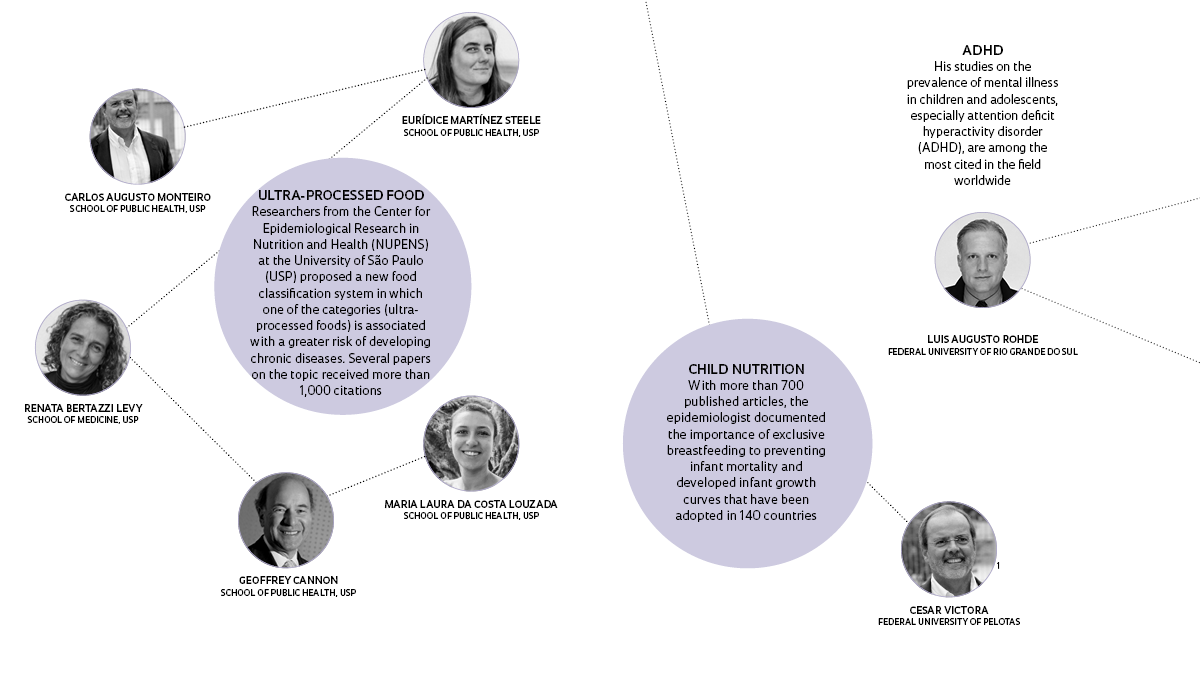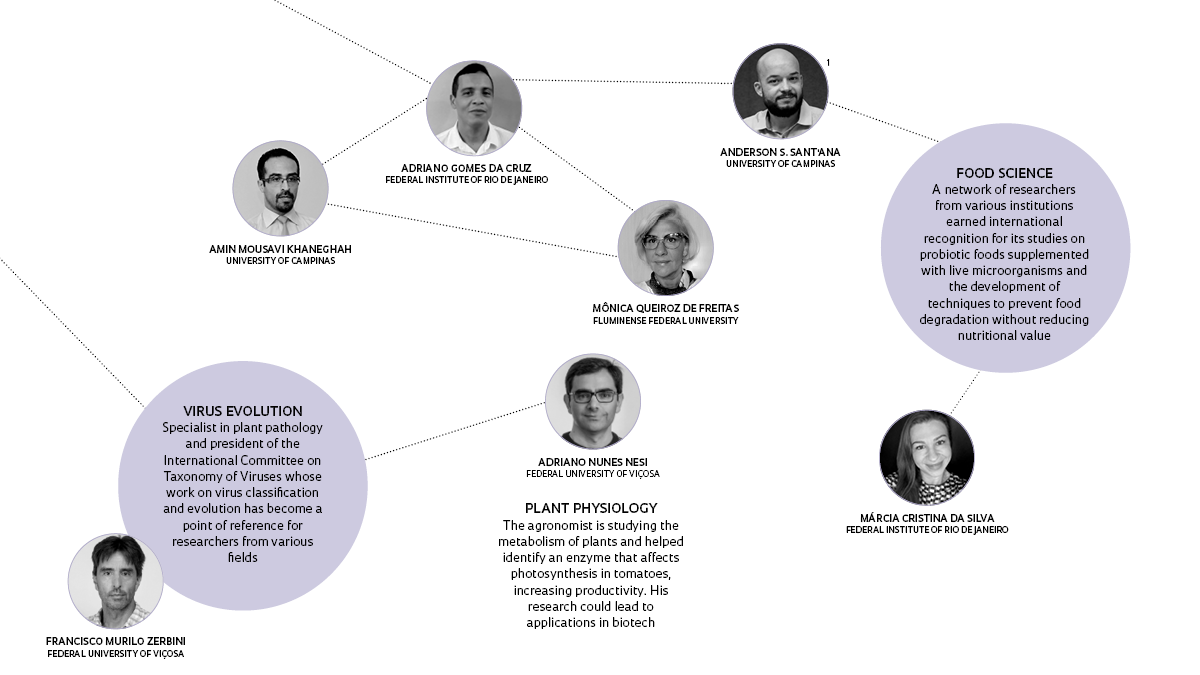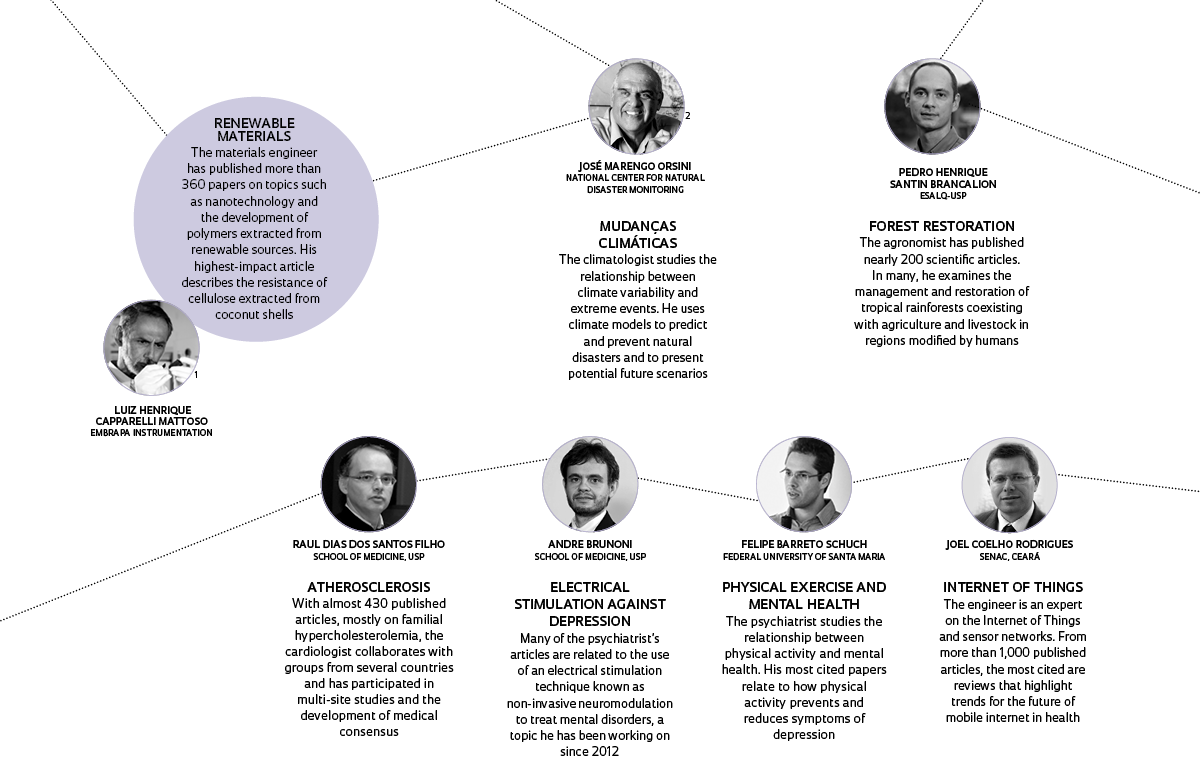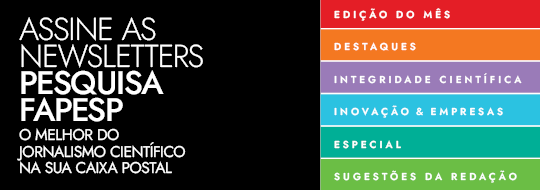Published annually by Clarivate Analytics, a list of the most cited scientists of the previous decade highlights a paradox in Brazilian research: despite constant growth of the country’s scientific output, few of its papers have a major international impact. In the 2021 edition of the list, released on November 16, only 21 of the 6,602 elite authors are from institutions in Brazil (0.3% of the total). In 2020, there were 19. But the Brazilian examples—in fields such as epidemiology, food science, virology, and climate change—show that it is possible to produce literature on hot topics in science that stimulate researchers worldwide. Citation numbers reflect to what extent an article has influenced the work of other authors enough to be referenced in their papers.
One of the best examples is the Center for Epidemiological Research in Nutrition and Health (NUPENS) at the University of São Paulo (USP), where five of the 21 Brazilian scientists work (see table). In 2010, NUPENS proposed a new theory that suggested eating processed food increases the risk of developing certain diseases (see Pesquisa FAPESP issue nº 265). “Our hypothesis is that the increased consumption of ultra-processed foods—industrially formulated macronutrients and additives containing little or no whole food—is the main cause behind the global obesity epidemic and other chronic diseases related to diet,” explains NUPENS coordinator Carlos Augusto Monteiro, an epidemiologist from USP’s School of Public Health (FSP). “As part of this theory, we created a food classification system based on how much they have been processed rather than their nutrient content, which we called the NOVA classification.”
 Photos: Personal Archive | 1 IEA / USP
Photos: Personal Archive | 1 IEA / USP
In recent years, researchers from universities in Europe and the USA have begun testing NUPENS’s theory using the NOVA classification. “This has led to hundreds of articles citing the papers we publish. Our work has expanded the list of chronic diseases related to the consumption of ultra-processed products,” he explains. Renata Bertazzi Levy, an epidemiologist from USP’s School of Medicine (FM) and NUPENS, says that the group’s work has impacted public policy. “We used the evidence generated with empirical data from Brazil to propose a recommended healthy diet based on the classification,” she says, referring to the Brazilian Food Guide published by the country’s Ministry of Health in 2014.
Over time, several other researchers worked with NUPENS—consequently joining the list of highly cited scientists alongside Monteiro and Levy. “We have collaborated with groups from the USA, the UK, Australia, and others, to test our hypotheses,” says Eurídice Martínez Steele, a biologist who is investigating the relationship between the consumption of ultra-processed foods and health outcomes.
“I came to Brazil believing that the future of public health lies in the global South. For me, this belief has come true,” says Geoffrey Cannon, a British researcher who has been working at NUPENS since 2000. “I came from Porto Alegre to do a doctorate at USP. I evaluated the impact of ultra-processed foods from the perspectives of both science and public policy,” says nutritionist Maria Laura da Costa Louzada, now a professor at FSP.
The Clarivate list also features a network of food scientists from São Paulo and Rio de Janeiro. Anderson S. Sant’Ana, from the School of Food Engineering at the University of Campinas (UNICAMP), studies harmful microorganisms that make food decompose and can cause disease, as well as microorganisms that are beneficial to human health, present in so-called probiotics. His most cited articles relate to studies on the occurrence and pathways of food contamination and the use of mathematical models to describe the behavior of probiotic microorganisms. His line of research on mycotoxins, substances produced by fungi that contribute to food decomposition and can cause disease, is linked to the work of another scientist on the list, Iranian researcher Amin Mousavi Khaneghah, one of Sant’Ana’s former doctoral students, who is currently doing a postdoctoral fellowship in his laboratory with a grant from FAPESP. The subject of his research is electron irradiation to decontaminate cookies. “So far, few studies have been carried out on mycotoxin levels in cookies,” explains Khaneghah. “Brazil’s food science is internationally competitive and supports the country’s agricultural production chain,” says Sant’Ana.
The UNICAMP group is collaborating with researchers from Fluminense Federal University (UFF) and the Rio de Janeiro Federal Institute for Education, Science, and Technology (IFRJ), which has created probiotic products such as yogurts, cheeses, and beverages. “There are consumers interested in increasing the nutritional value of their diets, and adding probiotics to dairy products has proven health benefits,” says Adriano Gomes da Cruz, a chemical engineer and head of IFRJ’s Food Processing Laboratory. “We have created cheeses, dairy drinks, ice cream, and flavored milks with functional characteristics, for which patent applications have been filed,” adds nutritionist Márcia Cristina da Silva, also a professor at IFRJ. Another area of interest for the group is ohmic heating, which involves passing an alternating electrical current through food. The technology could potentially be used to control the proliferation of pathogenic bacteria but without the nutritional losses caused by the widely used method of UHT sterilization. “The probiotics we used reacted well to ohmic heating, the effect of which is concentrated on pathogenic bacteria. The resulting products achieved excellent sensory acceptance and high functional potential, confirmed by studies in animals and humans,” explains Mônica Queiroz de Freitas, from the School of Veterinary Medicine at UFF. She has published 210 scientific articles and like Adriano Cruz and Márcia Silva, is listed among the highly cited scientists.
Clarivate developed a special methodology for drawing up the list that rewards the publication of multiple impactful articles by a researcher in the previous decade—an exceptional reaction to one or two articles is not enough to make the list. “These articles should be in the top 1% by citations for their field between 2010 and 2020,” said Clarivate analyst David Pendlebury when the list was published. The highest-impact paper by Raul Dias dos Santos Filho, a cardiologist from USP’s School of Medicine and Hospital Israelita Albert Einstein, was a guide to clinical protocols for preventing coronary heart disease in individuals with very high cholesterol. Published in the European Heart Journal in 2013, the article has been cited more than 2,300 times. Santos attributes his presence on Clarivate’s list to the interest generated by his main research topic: a genetic disease called Familial hypercholesterolemia, which causes atherosclerosis in young people. He pioneered the use of cardiac computed tomography for early detection of atherosclerosis in patients with the disease. He also made concerted efforts to collaborate with groups in Brazil and abroad, which helps to explain his high productivity—he has coauthored more than 430 articles. “It’s been 30 years of coordinated work. These collaborations gave me the opportunity to participate in multisite studies and international consensus on clinical guidelines,” he says.
 Photos: Personal Archive | 1 IEA / USP
Photos: Personal Archive | 1 IEA / USP
Luis Augusto Rohde, a psychiatry professor at the Federal University of Rio Grande do Sul (UFRGS) and a board member at UniEduk School of Medicine, stresses that to produce impactful science, it is essential to know how to ask good research questions. His studies on attention deficit hyperactivity disorder (ADHD), based on analysis of large epidemiological surveys of children and adolescents, had a major impact because they examined fundamental questions. “One of my articles was a meta-analysis of the scientific literature designed to answer the question: is there an over-eagerness or reluctance to prescribe medication for ADHD? Another assessed why ADHD is more prevalent in the USA than in Europe. We found that it is due to methodological differences.”
In addition to Rohde, other Brazilians studying mental disorders were also named on the 2021 list. Felipe Barreto Schuch, from the Federal University of Santa Maria, studies the relationship between physical activity and mental health. One of his most cited articles, from 2016, evaluated the effects of physical exercise on reducing the symptoms of depression. Another from 2018 showed that individuals without depression who are more physically active are at a lower risk of developing the disease. He also participated in a high-impact letter, written by a committee for the journal The Lancet in 2019, addressing the importance of physical health care for people with mental disorders. “The evidence of the relationship between physical activity and mental health is getting stronger and stronger.”
High-quality science is not possible without a good research infrastructure, points out André Brunoni, a psychiatrist at FM, USP. “The fact that I have a competitive laboratory was crucial to developing a national line of research,” says Brunoni, who received funding from FAPESP’s Young Investigators in Emerging Research Institutions program between 2013 and 2017 and has been leading a thematic project funded by the foundation since the beginning of the year. Since completing his doctorate in neuroscience in 2012, he has been working with non-invasive neuromodulation, an electrical stimulation technique used to treat depression. An electric current is transmitted to the subcutaneous tissue from electrodes attached to the head, modulating activity in the prefrontal cortex. The method is seen as an alternative to medication for depression. “We showed that neuromodulation can have a similar efficacy to drugs, and with fewer adverse effects,” he says, referring to a 2013 study, which has received more than 500 citations, comparing the effects of neuromodulation with the antidepressant drug sertraline.
Brazilian research on climate change has always had representatives on Clarivate’s list in previous years. The highlight this year was climatologist José Marengo Orsini, head of research and development at Brazil’s National Center for Natural Disaster Monitoring (CEMADEN), who specializes in the impacts and vulnerability to extremes of climate variability and climate change (see Pesquisa FAPESP issue nº 273). “Our monitoring and models assess the incidence of extreme weather and climate events to predict and thus reduce disaster risk. We also analyze how the current climate behaves in relation to climatic extremes and how it might behave in the future, in Brazil and Latin America, as global warming worsens,” he explains. His most renowned work among his more than 250 publications is a chapter in the Fifth Assessment Report by Working Group 2 of the Intergovernmental Panel on Climate Change (IPCC), published in 2014, for which he was one of the leading authors. It has been cited over 4,000 times.
One curious aspect of the Clarivate list is that of the 21 researchers from Brazilian institutions, five are foreigners who have settled in Brazil: Steele, from Spain, and Cannon, from England, both work at NUPENS, USP, while Khaneghah from UNICAMP is Iranian, Marengo from CEMADEN is Peruvian, and engineer Joel José Puga Coelho Rodrigues from SENAC in Ceará, who is head of research, development, and innovation at Fecomércio Ceará, was born in Portugal. Rodrigues is a specialist in information and communication technologies and has published over 1,000 articles. His most high-impact work was published in 2015 and has been cited some 800 times to date, according to the Web of Science database. It presents state of the art mobility solutions for health care and analyzed the industry’s best prospects for services and applications. Rodrigues arrived in Brazil in 2016. He has worked at a number of institutions, including the National Telecommunications Institute (INATEL) in Minas Gerais and the Federal University of Piauí—this year, he joined Fecomércio and SENAC in Fortaleza. “I chose Brazil to live in and ‘my Brazil’ is the Northeast,” he says. “I can work remotely with colleagues from all over the world, without having to go anywhere.” He recently collaborated on the Brazilian Ministry of Science, Technology, and Innovation’s Strategic Plan for the Internet of Things, and used his leadership and management experience to help the state of Piauí set up a COVID-19 field hospital in Teresina.
 Photos: Personal Archive | 1 Knalt Coups / Wikimedia Commons
Photos: Personal Archive | 1 Knalt Coups / Wikimedia Commons
Some studies have a high impact specifically because they are carried out in countries like Brazil. One example is the work of Cesar Victora, an epidemiologist from the Federal University of Pelotas (UFPel), whose contributions include documenting the importance of exclusive breastfeeding to prevent infant mortality and developing infant growth curves adopted in more than 140 countries. “I’ve been studying children’s health and nutrition in low- and middle-income countries, and this field is less studied than others such as cancer and cardiovascular disease. With fewer epidemiologists working in my area, it becomes easier to receive citations,” explains Victora. “I am proud to be included on this prestigious list.” He notes that his scientific output is the result of his success in creating a research group at UFPel in the 1980s. “I had a large number of colleagues and graduate and postdoc students whose productivity I constantly encouraged and demanded.”
Studies on the recovery of native ecosystems, especially rainforests, is a natural calling in Brazilian science, but Pedro Henrique Brancalion, an agronomist from USP’s Luiz de Queiroz College of Agriculture, says that the subject has only recently gained international attention. “I have a strong network of colleagues and was well positioned when interest in the topic began to grow. The UN chose ecosystem restoration as the central thematic issue of the decade 2021–2030,” says Brancalion, who also features on the list of highly cited scientists. His most impactful article, published in Nature in 2016, describes the restoration of carbon stocks in regenerated forests—it has been cited almost 700 times to date. Brancalion is currently leading a thematic research project funded by FAPESP, in collaboration with a group from Wageningen University in the Netherlands. “Our studies focused on forests that regenerated by themselves. Little is known about the benefits of agroforestry or reforestation of native species, which we are going to investigate next.”
Luiz Henrique Capparelli Mattoso, a materials engineer from EMBRAPA Instrumentation in São Carlos, São Paulo State, made the list thanks to his work developing plastic and composite materials from renewable sources. “We extract polysaccharides, whose macromolecules, when properly prepared, can replace synthetic plastics, reducing the environmental impact,” he explains. The potential applications include packaging production. “It is possible to make edible plastic films using over-ripe bananas or guavas that maintain their nutritional properties.” His most high-impact paper, with more than 900 citations, was published in the journal Carbohydrate Polymers, describing the characteristics of coconut shell cellulose nanocrystals obtained using a chemical process.
There are two professors list from the Federal University of Viçosa (UFV) on the 2021. The university is known for its research and teaching on human resources in agricultural sciences. Francisco Murilo Zerbini, an agronomist who specializes in plant pathology, was recognized for his studies on the evolution and classification of viruses. “Articles on taxonomy are frequently cited because they serve as a reference for any researcher working with viruses,” he explains. In 2017, he published an article with colleagues in the journal Nature Reviews Microbiology that has been cited more than 400 times. “It addresses with a specific issue of virology. Previously, to classify a virus, you had to obtain a culture of cells infected with it. A new form of classification has been proposed, based on the virus’s genome sequence alone. A lot of people disagreed, but after our article was published, this new method became accepted.”
Agronomist Adriano Nunes Nesi continued from his doctoral research, which he carried out in the early 2000s, including a sandwich period at the Max Planck Institute of Molecular Plant Physiology in Germany. Seeking to identify the physiological function of enzymes in the Krebs cycle, a stage of cell respiration that has been little studied in plants, he observed that one of the enzymes had a positive effect on photosynthesis in tomato plants. “The plants produced more tomatoes,” he recalls. Other enzymes were also characterized and their positive and negative effects identified. He later returned to Germany to do a postdoctoral fellowship. It was at this time, in 2010, that he published his most impactful work, an article in the journal Trends in Plant Science, which has received 459 citations. He continued studying the same field, incorporating other plant models. According to Nesi, understanding the function of these enzymes could lead to biotechnological applications. “This innovative research encourages collaborations. Students from research groups in other countries come to us, and my students go there,” he concludes.
Projects
1. Consumption of ultra-processed foods, nutritional profile of diet and obesity in seven countries (nº 15/14900-9); Grant Mechanism Thematic Project; Principal Investigator Carlos Augusto Monteiro (USP); Investment R$2,849,996.92.
2. Ultra-processed foods and the ‘protein leverage hypothesis’: a study in seven countries (nº 18/17972-9); Grant Mechanism Postdoctoral Fellowship; Principal Investigator Carlos Augusto Monteiro (USP); Grant Beneficiary Eurídice Martínez Steele; Investment R$305,246.34.
3. The consumption of ultra-processed foods and incidence of diabetes in the British population: Biobank cohort (nº 18/26660-0); Grant Mechanism Research Internship Abroad; Principal Investigator Renata Bertazzi Levy (USP); Host Christopher Millett (Imperial College London, England); Investment R$26,943.56.
4. The consumption of ultra-processed foods and nutritional quality indicators of the Australian diet (nº 16/14302-7); Grant Mechanism Postdoctoral Fellowship; Principal Investigator Renata Bertazzi Levy (USP); Grant Beneficiary Fernanda Rauber; Investment R$537,893.34.
5. The consumption of ultra-processed foods, nutritional profile and obesity data in Portugal (nº 15/14900-9); Grant Mechanism Regular Research Grant; Principal Investigator Renata Bertazzi Levy (USP); Investment R$402,911.99.
6. The impact of supermarkets on the availability and price of processed and ultra-processed foods in Brazil (nº 15/14900-9); Grant Mechanism Regular Research Grant; Principal Investigator Renata Bertazzi Levy (USP); Investment R$41,190.90.
7. Consumption of ultra-processed foods, nutritional profile of diet and health outcomes among children and adolescents in the United States (nº 16/25853-4); Grant Mechanism Postdoctoral Fellowship; Principal Investigator Renata Bertazzi Levy (USP); Grant Beneficiary Daniela Neri Gama de Almeida; Investment R$283,189.49.
8. Ultra-processed foods and their influence on free sugar content in the diet: a study in seven countries (nº 15/25168-7); Grant Mechanism Postdoctoral Fellowship; Principal Investigator Carlos Augusto Monteiro (USP); Grant Beneficiary Maria Laura da Costa Louzada; Investment R$96,299.23.
9. Consumption of ultra-processed foods and nutritional quality indicators of the Portuguese diet (nº 20/15788-6); Grant Mechanism Postdoctoral Fellowship; Principal Investigator Renata Bertazzi Levy (USP); Grant Beneficiary Luiza Antoniazzi Gomes de Gouveia; Investment R$145,987.38.
10. Consumption of ultra-processed foods and nutritional quality indicators of the Portuguese diet (nº 19/05972-7); Grant Mechanism Postdoctoral Fellowship; Principal Investigator Renata Bertazzi Levy (USP); Grant Beneficiary Renata Costa de Miranda; Investment R$139,557.58.
11. Consumption of ready-to-eat food products in Brazil and its influence on the nutritional status of the population (nº 13/08260-1); Grant Mechanism Research Internship Abroad; Supervisor Carlos Augusto Monteiro (USP); Supervisor Abroad Dariush Mozaffarian (Harvard-USA) Grant Beneficiary Maria Laura da Costa Louzada; Investment R$37,997.32.
12. Consumption of ultra-processed food products in Brazil and its influence on diet quality and the nutritional status of the population (nº 12/18027-0); Grant Mechanism Doctoral (PhD) Fellowship; Supervisor Carlos Augusto Monteiro (USP); Grant Beneficiary Maria Laura da Costa Louzada; Investment R$145,213.95.
13. “PredicAquaMics” – A study on the quality, microbiological safety, predictive modeling, and microbial diversity in mineral waters (nº 17/22455-0); Grant Mechanism Regular Research Grant; Principal Investigator Anderson de Souza Sant’Ana (UNICAMP); Investment R$189,152.61.
14. Production and stabilization of new starter yeasts isolated from artisanal Brazilian cheeses (nº 18/19311-0); Grant Mechanism Postdoctoral Fellowship; Supervisor Anderson de Souza Sant’Ana (UNICAMP); Grant Beneficiary Antonio de Anchieta Câmara Júnior; Investment R$640,567.75.
15. Isolated yeasts from Brazilian artisanal cheeses: a comparative genomic approach to study the adaptation, evolution, and domestication of strains relative to the cheese habitat (nº 21/07175-7); Grant Mechanism Research Internship Abroad; Supervisor Anderson de Souza Sant’Ana (UNICAMP); Supervisor Abroad Tatiana Giraud (Université Paris-Sud, Paris 11, France); Grant Beneficiary Antonio de Anchieta Câmara Júnior; Investment R$326,854.30.
16. The application of electron beam technology in the detoxification of mycotoxins in cereal-based products and its comparison with conventional techniques: a case study involving crackers (nº 18/15432-7); Grant Mechanism Postdoctoral Fellowship; Supervisor Anderson de Souza Sant’Ana (Unicamp); Grant Beneficiary Amin Mousavi Khaneghah; Investment R$314,841.19.
17. Processing sheep milk by ohmic heating for yogurt production: the inactivation of pathogens and study of microbial ecology during shelf life by 16S rRNA gene amplicon sequencing (nº 18/24540-8); Grant Mechanism Postdoctoral Fellowship; Supervisor Anderson de Souza Sant’Ana (UNICAMP); Grant Beneficiary Celso Fasura Balthazar; Investment R$312,919.10.
18. The assessment of subclinical atherosclerosis in patients with markedly elevated HDL cholesterol (nº10/20212-4); Grant Mechanism Regular Research Grant; Principal Investigator Raul Dias dos Santos Filho (USP); Investment R$115,357.80.
19. INCT for Climate Change (nº 14/50848-9); Grant Mechanism Thematic Project; Program Global Climate Change; Principal Investigator Jose Antonio Marengo Orsini (CEMADEN); Investment R$4,293,569.78.
20. An integrated framework for the analysis of local decision-making and adaptive capacity for large-scale environmental change: case studies of communities in Brazil, the UK, and the US (nº 12/51876-0); Grant Mechanism Thematic Project; Principal Investigator Jose Antonio Marengo Orsini (CEMADEN); Investment R$711,506.53.
21. Obtaining, characterizing, and chemically modifying nanofibers of renewable origin for use as reinforcement of polyolefin resins (nº 08/03606-9); Grant Mechanism Bioenergy Research (Bioen) – Research Partnership for Technological Innovation Program (PITE); Agreement Braskem; Principal Investigator Luiz Henrique Capparelli Mattoso (EMBRAPA); Investment R$239,321.59.
22. Exploring the potential of biopolymer nanoparticles with fruit extracts to control food pathogens (nº 19/22799-7); Grant Mechanism Postdoctoral Fellowship; Supervisor Luiz Henrique Capparelli Mattoso (EMBRAPA); Grant Beneficiary Crisiane Aparecida Marangon; Investment R$202,022.94.
23. Non-implantable neuromodulation therapies: a perspective for the depressed brain (nº 19/06009-6); Grant Mechanism Thematic Project; Principal Investigator Andre Russowsky Brunoni (USP); Investment R$813,882.37.
24. Multimodal assessment of the effects of transcranial direct current stimulation and theta-burst stimulation on prefrontal cortex function: A double-blind, placebo-controlled, factorial Phase-I study (nº 18/10861-7); Agreement Research Foundation – Flanders (FWO) Grant Mechanism Regular Research Grant; Principal Investigator Andre Russowsky Brunoni (USP); Principal Investigator Abroad Marie-Anne Vanderhasselt (UGhent, Belgium) Investment R$270,682.86.
25. Escitalopram and transcranial direct current stimulation in major depressive disorder patients: A randomized, double-blind, placebo-controlled, non-inferiority clinical trial (nº 12/20911-5); Grant Mechanism Young Investigator Award; Principal Investigator Andre Russowsky Brunoni (USP); Investment R$627,566.96.
26. Understanding restored forests for the benefit of people and nature – NewFor (nº 18/18416-2); Grant Mechanism Thematic Project; Program Biota; Agreement Dutch Research Council (NWO); Principal Investigator Pedro Henrique Santin Brancalion (USP); Principal Investigator Abroad Franciscus Johannes Jozef Maria Bongers (Wageningen University & Research, Netherlands); Investment R$1,659,863.08.
27. Mixed forest plantations for mitigation and adaptation to climate change – MixForChange (nº 19/24318-6); Grant Mechanism Regular Research Grant; Program Biota; Principal Investigator Pedro Henrique Santin Brancalion (USP); Investment R$233,496.00.
28. The use of glyphosate in the restoration of riparian forests: potential for soil and water pollution and silvicultural aspects (nº 12/19771-4); Grant Mechanism Regular Research Grant; Principal Investigator Pedro Henrique Santin Brancalion (USP); Investment R$64,884.23.
29. Application of survival analysis to adjust the concentration of glucose oxidase in probiotic yogurt (nº 09/14302-3); Grant Mechanism Postdoctoral Fellowship; Supervisor José de Assis Fonseca Faria (UNICAMP); Grant Beneficiary Adriano Gomes da Cruz; Investment R$133,538.86.
